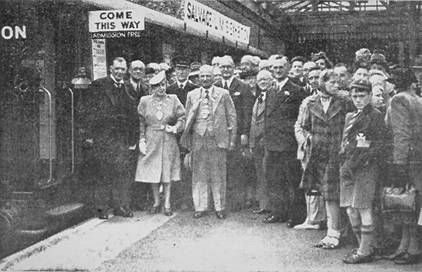L.M.S. Salvage Coach, 1942
Newspaper report about the L.M.S. Salvage Coach which visited Lytham
St.Annes in August 1942.
L.M.S. SALVAGE
COACH.
Exhibition at St. Annes opened by
Mayor.
THE L.M.S. Railway Company's salvage
exhibition was on view at St. Annes on Wednesday and was
visited by a large number of people. It comprised a coach showing materials that
can be made from salvage, and another coach containing a film
unit.
The object of the exhibition is to stimulate the
salvage effort among railway men and the public.
The 34-years-old coach was damaged in
an air raid and was scheduled for breaking up, but was salvaged to
house the exhibition and all the materials in the exhibition are also
salvaged.
The walls are lined with balloon fabric salvaged
from balloons damaged whilst guarding our towns and cities. The cast-iron letters
used as slogans were made from the names of railway stations removed in 1940. The
exhibits show how salvage is turned into serviceable materials used in the war
effort.

“WASTE IS
UNPATRIOTIC."
Mr. Ashton Davies, C.V.O.,
0.B.E., vice-president of the L.M.S., who introduced the
Mayor, said that the coach was symbolic of the great part being played by the
L.M.S. in salvage. The L.M.S., actually, were pioneers in
salvage.
In the last six months alone they had salvaged 2,375
tons of metal, 2,752 tons of paper, and 178,816 bottles. Frequently the necks of
bottles were broken, but they were turning them into tumblers. They had put more
than a hundred million sheets of paper back into service during the same
period.
“We want to utilise this coach," he
continued. “to encourage our own effort and introduce the
public to a great scheme. Waste is unpatriotic."
The Mayor, in opening the exhibition, said he
wanted, as Mayor, to express his great appreciation of what the L.M.S. had done for
this Borough both before and since its incorporation. That indebtedness to the
Railway Company had been brought about by the very good offices of their real
friend, Mr. Ashton Davies.
COLOSSAL EFFORT.
The public knew far too little of the part being
played by the L.M.S. in the national effort. He could assure them that that effort
had been colossal. Indeed, if ever the story of the part played by the L.M.S. came
to be published in full it would be found to be not merely a fascinating story but
an amazing one.
That effort had been made in spite of many obstacles
and difficulties which at times must have seemed to be almost insuperable. Those
who knew Mr. Ashton Davies, however, knew that he, like other great leaders, did
not recognise the word impossible.
Everybody should see that exhibition, and those who
did see it would realise the effort being made by one of the greatest concerns in
the country. They should also, at the same time, realise that even the smallest and
meanest article might be used to further the country's war
effort.
The Mayor expressed his thanks to Mr. Ashton Davies
and the L.M.S. for the opportunity of seeing the exhibition and also for their
contribution to the war effort.
The Mayor was supported by the
Mayoress, Coun. and Mrs. J. Kay (Deputy Mayor and Deputy
Mayoress), the Town Clerk (Mr. Walter Heap), Mrs. Heap and many members of the
Council.
|